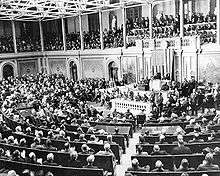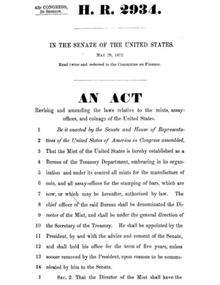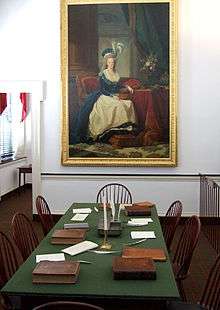Procedures of the United States Congress
Procedures of the United States Congress are established ways of doing legislative business. Congress has two-year terms with one session each year. There are rules and procedures, often complex, which guide how it converts ideas for legislation into laws.

Sessions
A term of Congress is divided into two "sessions", one for each year; Congress has occasionally also been called into an extra, (or special) session (the Constitution requires Congress to meet at least once each year). A new session commences on January 3 (or another date, if Congress so chooses) each year. Before the Twentieth Amendment, Congress met from the first Monday in December to April or May in the first session of their term (the "long session"); and from December to March 4 in the second "short session". (The new Congress would then meet for some days, for the inauguration, swearing in new members, and organization.)
The Constitution forbids either house from meeting any place outside the Capital, or from adjourning for more than three days, without the consent of the other house. The provision was intended to prevent one house from thwarting legislative business simply by refusing to meet. To avoid obtaining consent during long recesses, the House or Senate may sometimes hold pro forma meetings, sometimes only minutes long, every three days. The consent of both bodies is required for Congress's final adjournment, or adjournment sine die, at the end of each congressional session. If the two houses cannot agree on a date, the Constitution permits the President to settle the dispute.
Joint sessions
Joint Sessions of the United States Congress occur on special occasions that require a concurrent resolution from both House and Senate. These sessions include the counting of electoral votes following a Presidential election and the President's State of the Union address. Other meetings of both House and Senate are called Joint Meetings of Congress, held after unanimous consent agreements to recess and meet. Meetings of Congress for Presidential Inaugurations may also be Joint Sessions, if both House and Senate are in session at the time, otherwise they are formal joint gatherings.

At some time during the first two months of each session, the President customarily delivers the State of the Union Address, a speech in which he assesses the situation of the country and outlines his legislative proposals for the congressional session. The speech is modeled on the Speech from the Throne given by the British monarch, and is mandated by the Constitution of the United States—though it is not necessarily required to be delivered each year or in the customary manner. Thomas Jefferson discontinued the original practice of delivering the speech in person before both houses of Congress, deeming it too monarchical. Instead, Jefferson and his successors sent a written message to Congress each year. In 1913, President Woodrow Wilson reestablished the practice of personally attending to deliver the speech; few Presidents have deviated from this custom since.
Joint Sessions and Joint Meetings are traditionally presided over by the Speaker of the House except for the joint session to count electoral votes for President, when the Constitution requires the President of the Senate (the Vice President of the United States) to preside.
Bills and resolutions

Ideas for legislation can come from many areas, including members, lobbyists, state legislatures, constituents, legislative counsel, an executive agency such as the president or cabinet officer or executive agency, and the usual next step is for the proposal to be passed to a committee for review.[2] A proposal has usually one of four principal forms: the bill, the joint resolution, the concurrent resolution, and the simple resolution.[3]
_Press_Conference.jpg)
- Bills are laws in the making. A House-originated bill begins with the letters "H.R." for "House of Representatives", followed by a number kept as it progresses.[3] It is presented to the president after both Houses agree.[3]
- Joint resolutions There is little practical difference between a bill and a joint resolution since both are treated similarly; a joint resolution originating from the House, for example, begins "H.J.Res." followed by its number.[3]
- Concurrent Resolutions affect only the House and Senate, and accordingly aren't presented to the president for approval later. In the House, it begins with "H.Con.Res."[3]
- Simple resolutions concern only the House or only the Senate and begin with "H.Res."[3]
Any member of Congress may introduce a bill at any time while the House is in session by placing it in the hopper on the Clerk's desk.[3] A sponsor's signature is required, and there can be many co-sponsors. It's assigned a number by the Clerk. Then it's referred to a committee.[3] Committees study each bill intensely at this stage.[3]

The most important executive communication is usually the president's annual message which contains a lengthy budget proposal.[2] Drafting statutes is an art that requires "great skill, knowledge, and experience."[2] Congressional committees sometimes draft bills after studies and hearings covering periods of a year or more.[2] A proposal may be introduced in Congress as a bill, a joint resolution, a concurrent resolution, or a simple resolution. Most legislative proposals are introduced as bills, but some are introduced as joint resolutions. There is little practical difference between the two, except that joint resolutions may include preambles but bills may not. Joint resolutions are the normal method used to propose a constitutional amendment or to declare war. On the other hand, concurrent resolutions (passed by both houses) and simple resolutions (passed by only one house) do not have the force of law. Instead, they serve to express the opinion of Congress, or to regulate procedure. In many cases, lobbyists write legislation and submit it to a member for introduction. Congressional lobbyists are legally required to be registered in a central database.
How bills become laws
Bills may be introduced by any member of either house. However, the Constitution provides that: "All bills for raising Revenue shall originate in the House of Representatives." As a result, the Senate does not have the power to initiate bills imposing taxes. Furthermore, the House of Representatives holds that the Senate does not have the power to originate appropriation bills, or bills authorizing the expenditure of federal funds. Historically, the Senate has disputed the interpretation advocated by the House. However, whenever the Senate originates an appropriations bill, the House simply refuses to consider it, thereby settling the dispute in practice. Nevertheless, while the Senate cannot originate revenue and appropriation bills, it does retain the power to amend or reject them. A congressional act in 1974 established procedures to try to establish appropriate annual spending levels.[4]

Each bill goes through several stages in each house. The first stage involves consideration by a committee which often seeks input from relevant departments as well as requests feedback from the Government Accountability Office.[5] Most legislation is considered by standing committees, each of which has jurisdiction over a particular subject matter, such as Agriculture or Appropriations. The House has twenty standing committees; the Senate has sixteen. Standing committees meet at least once each month.[6] Almost all standing committee meetings for transacting business must be open to the public unless the committee votes, publicly, to close the meeting.[6] Open committee meetings may be covered by the media.[6] In some cases, bills may be sent to select committees, which tend to have more narrow jurisdictions than standing committees. If a bill is important, the committee may set a date for public hearings announced by the committee's chairman.[7] Each standing and select committee is led by a chair (who belongs to the majority party) and a ranking member (who belongs to the minority party). Witnesses and experts can present their case for or against a bill.[3] Sometimes transcripts of these meetings are made public.[3] Then, a bill may go to what's called a mark-up session where committee members debate the bill's merits and may offer amendments or revisions.[3] Committees are permitted to hold hearings and collect evidence when considering bills. They may also amend the bill, but the full house holds the power to accept or reject committee amendments. After considering and debating a measure, the committee votes on whether it wishes to report the measure to the full house. Not reporting a bill or tabling it means it has been rejected. If amendments to a bill are extensive, then sometimes a new bill with all the amendments built in will be written, sometimes known as a clean bill with a new number.[3]
Both houses provide for procedures under which the committee can be bypassed or overruled, but they are rarely used. If reported by the committee, the bill reaches the floor of the full house which considers it. This can be simple or complex.[3] Consideration of a bill requires, itself, a rule which is a simple resolution hammering out the particulars of debate––time limits, possibility of further amendments, and such.[3] Each side has equal time and members can yield to other members who wish to speak.[3] Sometimes opponents seek to recommit a bill which means to change part of it.[3] Generally, discussion requires a quorum, usually half of the total number of representatives, before discussion can begin, although there are exceptions.[8]
The house may debate and amend the bill; the precise procedures used by the House of Representatives and the Senate differ. A final vote on the bill follows.
Once a bill is approved by one house, it is sent to the other, which may pass, reject, or amend it. For the bill to become law, both houses must agree to identical versions of the bill.[3] If the second house amends the bill, then the differences between the two versions must be reconciled in a conference committee, an ad hoc committee that includes both senators and representatives.[3] One mechanism Congress uses to work within revenue constraints is called the reconciliation process which is a multiple step way to keep new budgets within the bounds of existing ones.[4] In addition, both Houses use a budget enforcement mechanism informally known as pay-as-you-go or paygo which discourages members from considering acts which increase budget deficits.[4]
In many cases, conference committees have introduced substantial changes to bills and added unrequested spending, significantly departing from both the House and Senate versions. President Ronald Reagan once quipped, "If an orange and an apple went into conference consultations, it might come out a pear."[9] If both houses agree to the version reported by the conference committee, the bill passes; otherwise, it fails.
There are a variety of means for members to vote on bills, including systems using lights and bells and electronic voting.[10] Most votes, including quorum votes, are done electronically, and allow members to vote yea or nay or present.[10] They light up when the vote is in process.[10] Members insert a voting ID card and can change their votes during the last five minutes if they choose; in addition, paper ballots are used on some occasions (yea indicated by the color green, nay by red.)[10] To conduct a voice vote the chairman asks As many as are in favor say Aye, as many as are opposed, say No.[10] Rules permit live media coverage of voting, although prohibit use of these broadcasts for political purposes or political advertisements.[10] House rules require a three-fifths vote to pass a ruling that contains a specified federal income tax rate increase.[10] One member can't cast a vote for another member.[10] It's possible for citizens to learn how congresspersons voted by consulting an online database.[11]

After passage by both houses, a bill is considered to be enrolled and is sent to the president for approval.[3] The president may sign the bill and make it law. The President may also choose to veto the bill, returning it to Congress with his objections. In such a case, the bill only becomes law if each house of Congress votes to override the veto with a two-thirds majority. Finally, the president may choose to take no action, neither signing nor vetoing the bill. In such a case, the Constitution states that the bill automatically becomes law after ten days, excluding Sundays, unless Congress is adjourned during this period. Therefore, the president may veto legislation passed at the end of a congressional session simply by ignoring it; the maneuver is known as a pocket veto, and cannot be overridden by the adjourned Congress.
Every Act of Congress or joint resolution begins with an enacting formula or resolving formula stipulated by law. These are:
- Act of Congress: "Be it enacted by the Senate and House of Representatives of the United States of America in Congress assembled."
- Joint resolution: "Resolved by the Senate and House of Representatives of the United States of America in Congress assembled."
Quorum and vote
The Constitution specifies that a majority of members constitutes a quorum to do business in each house. The rules of each house provide that a quorum is assumed to be present unless a quorum call demonstrates the contrary. Representatives and senators rarely force the presence of a quorum by demanding quorum calls; thus, in most cases, debates continue even if a majority is not present.
Both houses use voice voting to decide most matters; members shout out "aye" or "no," and the presiding officer announces the result. The Constitution, however, requires a recorded vote on the demand of one-fifth of the members present. If the result of the voice vote is unclear, or if the matter is controversial, a recorded vote usually ensues. The Senate uses roll-call votes; a clerk calls out the names of all the senators, each senator stating "aye" or "no" when his or her name is announced. The House reserves roll-call votes for the most formal matters, as a roll-call of all 435 representatives takes quite some time; normally, members vote by electronic device. In the case of a tie, the motion in question fails. In the Senate, the Vice President may (if present) cast the tiebreaking vote.
References
- ↑ “How Our Laws Are Made” infographic by Mike Wirth and Dr. Suzanne Cooper-Guasco for Sunlight Foundation “Design for America Competition” 2010, sources: “How Our Laws Are Made” by John V. Sullivan (Rev. 6.24.07 thomas.loc.gov) and What is a Lobbyist? - wiseGEEK and Reconciliation in the Senate - Brookings Institution.
- 1 2 3 4 John V. Sullivan (July 24, 2007). "How Our Laws Are Made". The Library of Congress. Retrieved 2010-09-11.
Sources of ideas for legislation are unlimited and proposed drafts of bills originate in many diverse quarters.
- 1 2 3 4 5 6 7 8 9 10 11 12 13 14 15 16 17 18 19 20 111th Congress, 2nd session (2010). "Tying It All Together: Learn about the Legislative Process". United States House of Representatives. Retrieved 2010-09-11.
The chief function of Congress is the making of laws.
- 1 2 3 John V. Sullivan (July 24, 2007). "How Our Laws Are Made". The Library of Congress. Retrieved 2010-09-11.
The Congressional Budget and Impoundment Control Act of 1974, as amended, provides Congress with a procedure to establish appropriate spending and revenue levels for each year. The congressional budget process, as set out in that Act, is designed to coordinate decisions on sources and levels of revenues and on objects and levels of expenditures.
- ↑ John V. Sullivan (July 24, 2007). "How Our Laws Are Made". The Library of Congress. Retrieved 2010-09-11.
One of the first actions taken by a committee is to seek the input of the relevant departments and agencies about a bill. Frequently, the bill is also submitted to the Government Accountability Office with a request for an official report of views on the necessity or desirability of enacting the bill into law. Normally, ample time is given for the submission of the reports and they are accorded serious consideration.
- 1 2 3 John V. Sullivan (July 24, 2007). "How Our Laws Are Made". The Library of Congress. Retrieved 2010-09-11.
Standing committees are required to have regular meeting days at least once a month.
- ↑ John V. Sullivan (July 24, 2007). "How Our Laws Are Made". The Library of Congress. Retrieved 2010-09-11.
If the bill is of sufficient importance, the committee may set a date for public hearings. The chairman of each committee, except for the Committee on Rules, is required to make public announcement of the date, place, and subject matter of any hearing at least one week before the commencement of that hearing, unless the committee chairman with the concurrence of the ranking minority member or the committee by majority vote determines that there is good cause to begin the hearing at an earlier date. If that determination is made, the chairman must make a public announcement to that effect at the earliest possible date.
- ↑ "NEWS FROM WASHINGTON". The New York Times. December 3, 1861. Retrieved 2010-09-11.
Congress assembled to-day, and contrary to expectations, more than a quorum was present in each House. From the Senate, BRECKINRIDGE, of Kentucky, and JOHNSON, of Missouri, were absent -- both now holding commands in the rebel army. Senators POWELL, BAYARD and POLK, whose sympathy with the rebellion during the extra session and since were too apparent to be consistent with their resuming their seats, were nevertheless present. JOHNSON, of Tennessee, was absent, being now near his home looking after the interests of his constituents.
- ↑ "The 7-step towards formalisation of Indo-US nuke Bill". Yahoo! News India. ANI. 2006-11-17. Retrieved 2007-08-04.
If an orange and an apple went into conference consultations, it might come out a pear
- 1 2 3 4 5 6 7 8 John V. Sullivan (July 24, 2007). "How Our Laws Are Made". The Library of Congress. Retrieved 2010-09-11.
System of Lights and Bells -- Due to the diverse nature of daily tasks that they have to perform, it is not practicable for Members to be present in the House or Senate Chamber at every minute that the body is in session. Furthermore, many of the routine matters do not require the personal attendance of all the Members. A system consisting of electric lights and bells or buzzers located in various parts of the Capitol Building and House and Senate Office Buildings alerts Members to certain occurrences in the House and Senate Chambers. In the House, the Speaker has ordered that the bells and lights comprising the system be utilized as follows....
- ↑ United States government. "Recent Votes". United States Senate. Retrieved 2010-09-11.
External links
| Wikimedia Commons has media related to United States Congress. |
| Wikiquote has quotations related to: Procedures of the United States Congress |
- How Laws Are Made, via U.S. Government Printing Office
- How Our Laws Are Made by John V. Sullivan, 2007. Detailed information about rules and procedures of the Congress.
- Congressional Glossary, via C-SPAN
- Selected Congressional Research Service Reports on Congress and Its Procedures, via Law Librarians' Society of Washington, D.C.
- Thomas Legislative Information via Library of Congress